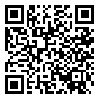دوره 8، شماره 4 - ( 10-1399 )
جلد 8 شماره 4 صفحات 160-156 |
برگشت به فهرست نسخه ها
Download citation:
BibTeX | RIS | EndNote | Medlars | ProCite | Reference Manager | RefWorks
Send citation to:



BibTeX | RIS | EndNote | Medlars | ProCite | Reference Manager | RefWorks
Send citation to:
Alizadeh Otaghvar H, Afsordeh K, Hosseini M, Mazhari N, Dousti M. Causes of wound dehiscence in trauma patients with penetrating and non-penetrating abdominal wound in Rasool Akram Hospital within 2017-2020. J Surg Trauma 2020; 8 (4) :156-160
URL: http://jsurgery.bums.ac.ir/article-1-242-fa.html
URL: http://jsurgery.bums.ac.ir/article-1-242-fa.html
Causes of wound dehiscence in trauma patients with penetrating and non-penetrating abdominal wound in Rasool Akram Hospital within 2017-2020. نشریه جراحی و تروما. 1399; 8 (4) :156-160
چکیده: (3412 مشاهده)
Introduction: Wound dehiscence is one of the serious complications of surgery that is associated with mortality and morbidity (about 45%); moreover, it increases medical costs. The present study assessed the incidence and predictors of wound dehiscence in trauma patients referred to Hazrat Rasool Akram Hospital.
Methods: This cross-sectional study was conducted on all trauma patients with penetrating or non-penetrating abdominal wounds referred to Hazrat Rasool Akram Hospital within April 2017-March 2020. Patients were evaluated in two stages, three days after the surgery and one month later. The data were analyzed in SPSS software (version 19) using Fisher's exact tests, independent t-test, Pearson's correlation coefficient, and chi-square test. A p-value less than 0.05 was considered statistically significant.
Results: The present study included 154 patients with a mean age of 43.53±16.81(age range:16-91 years). Moreover, the majority of the cases were female (n=86; 55.8%). The wound of 20 (13%) patients did not heal. There was a significant relationship between male gender and wound dehiscence (P=0.013). The two groups did not differ in age, smoking, alcohol or opioid use, and the type of surgery. Nevertheless, wound dehiscence was significantly correlated with chemotherapy and the number of sessions. The number of hospitalization days was significantly higher in the group with wound dehiscence (P=0.001). Furthermore, wound dehiscence was closely correlated with low albumin, low hemoglobin, low hematocrit (leading to anemia), and high bilirubin (leading to jaundice).
Conclusions: As evidenced by the obtained results, wound dehiscence was significantly correlated with gender, low albumin, low hemoglobin, low hematocrit, bilirubin elevation, steroid usage, and chemotherapy history.
Methods: This cross-sectional study was conducted on all trauma patients with penetrating or non-penetrating abdominal wounds referred to Hazrat Rasool Akram Hospital within April 2017-March 2020. Patients were evaluated in two stages, three days after the surgery and one month later. The data were analyzed in SPSS software (version 19) using Fisher's exact tests, independent t-test, Pearson's correlation coefficient, and chi-square test. A p-value less than 0.05 was considered statistically significant.
Results: The present study included 154 patients with a mean age of 43.53±16.81(age range:16-91 years). Moreover, the majority of the cases were female (n=86; 55.8%). The wound of 20 (13%) patients did not heal. There was a significant relationship between male gender and wound dehiscence (P=0.013). The two groups did not differ in age, smoking, alcohol or opioid use, and the type of surgery. Nevertheless, wound dehiscence was significantly correlated with chemotherapy and the number of sessions. The number of hospitalization days was significantly higher in the group with wound dehiscence (P=0.001). Furthermore, wound dehiscence was closely correlated with low albumin, low hemoglobin, low hematocrit (leading to anemia), and high bilirubin (leading to jaundice).
Conclusions: As evidenced by the obtained results, wound dehiscence was significantly correlated with gender, low albumin, low hemoglobin, low hematocrit, bilirubin elevation, steroid usage, and chemotherapy history.
نوع مطالعه: پژوهشي |
موضوع مقاله:
جراحی عمومی
دریافت: 1399/2/22 | پذیرش: 1399/11/5 | انتشار الکترونیک پیش از انتشار نهایی: 1399/11/24 | انتشار: 1399/11/24
دریافت: 1399/2/22 | پذیرش: 1399/11/5 | انتشار الکترونیک پیش از انتشار نهایی: 1399/11/24 | انتشار: 1399/11/24
attachement [HTML 87 KB] (106 دریافت)
| بازنشر اطلاعات | |
 |
این مقاله تحت شرایط Creative Commons Attribution-NonCommercial 4.0 International License قابل بازنشر است. |




